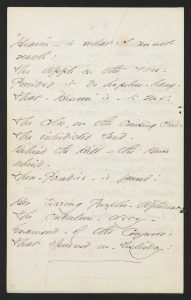“Heaven” – is what I cannot
reach!
The Apple on the Tree –
Provided it do hopeless – hang –
That – “Heaven” is – to Me!
The Color, on the cruising cloud –
The interdicted Land –
Behind the Hill – the House
behind –
There – Paradise – is found!
Her teazing Purples – Afternoons –
The credulous – decoy –
Enamored – of the Conjuror –
That spurned us – Yesterday!
Link to EDA manuscript. Originally in Packet XIV, Mixed Fasciles, ca. 1860-1862. First published in Poems (1896), 17, the first two stanzas. Courtesy of Houghton Library, Harvard University, Cambridge, Mass.
This is an excellent example of Dickinson’s most frequently used form, the common meter, an accentual-syllabic quatrain of 8686 rhyming abcb. It is the form of many of her most memorable poems, such as “ A solemn thing – it was – I said” (F307), “I heard a Fly buzz – when I died” (F591), “My Life had stood a Loaded Gun” (F764), “Alone and in a Circumstance” (F1174), to mention just a few. It maintains a consistent stanza structure throughout, but shows that in this popular form and despite its regularity, Dickinson could produce poems of great power and effect.
It is notable that though the rhythm of the poem is iambic, that is, made up of feet of two syllables of unstressed/stressed (uS), the first word of the poem, “Heaven,” is what we call a “trochee,” a foot where the syllables are stressed/unstressed (Su), which gives the poem an emphatic start. A similar but even more disrupting emphasis occurs in line 8, “There – Paradise – is found,” where both syllables of the first foot “There – Par” are stressed (SS). This is called a “spondee” and creates a double beat at the opening of this emphatic line of discovery (and contradiction of orthodox belief) that reinforces it; we cannot miss it.
Heaven is, of course, a frequent and important subject in hymns. Here, Dickinson puts the word in quotation marks, as if it is an ironic citation of a concept she has heard about but does not accept as truth. She rejected traditional Calvinist teachings that heaven was an afterlife reward for denying oneself earthly pleasures. In a later poem from 1883, she wrote: “Who has not found the Heaven – below –/ Will fail of it above –“ (F1609B, J1544).
The first stanza rehearses and reverses the temptation in Eden. Linda Munk comments on the thematic irony of the poem: “In three quatrains, she effectively revises Paradise Lost. … The Miltonic Heaven is not Dickinson’s.” Our study of Dickinson’s meter allows us to see how this irony is augmented by the poet’s choice of meter – definitely NOT the blank verse of the English tradition of epic poems.


